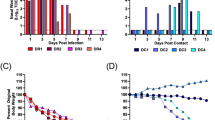Summary
The pathogenesis and transmission of infection with the Moscow strain of ectromelia virus were studied in inbred mice. BALB/cAnNcr had high morbidity and mortality and C57BL/6Ncr (B6) mice had high morbidity and low mortality. Virus was detected in B6 mice for 2 weeks after subcutaneous (s.c.) inoculation and infected mice developed lesions compatible with acute mousepox. B6 inoculated by footpad transmitted infection to cagemates for up to five weeks and soiled cages that had housed infected mice were infectious for three weeks. S.c.-inoculated B6 mice also transmitted by contact for 2 weeks. Transmission was attributed to oronasal excretion of virus. Airborne transmission of infection between adjacent cages occurred at a low rate. Ectromelia virus-free progeny were derived from previously infected dams. These studies indicate that the highly virulent and infectious Moscow strain of ectromelia virus caused self-limiting infection in inbred mice and that direct contact is the most efficient means of transmission. These findings support the concept that mousepox can be contained by husbandry practices that minimize or eliminate the spread of infection by direct contact or fomites.
Similar content being viewed by others
References
Bhatt PN, Jacoby RO (1987) Mousepox in inbred mice innately resistant or susceptible to lethal infection with ectromelia virus. I. Clinical responses. Lab Anim Sci 37: 9–13
Bhatt PN, Jacoby RO (1987) Mousepox in inbred mice innately resistant or susceptible to lethal infection with ectromelia virus. III. Experimental transmission of infection and derivation of virus-free progeny from previously infected dams. Lab Anim Sci 37: 23–28
Fenner F (1947) Studies in infectious ectromelia in mice (mouse-pox). III. Natural transmission: elimination of the virus. Aust J Exp Biol Med Sci 25: 327–335
Fenner F (1949) Studies in mousepox (infectious ectromelia of mice). VI. A comparison of the virulence and infectivity of three strains of ectromelia virus. Aust J Exp Biol Med Sci 27: 31–43
Fenner F (1949) Mousepox (infectious ectromelia): a review. J Immunol 63: 341–373
Fenner F (1988) Personal communication
Hsu SM, Raine L, Fanger H (1981) Use of avidin-biotin-peroxidase complex (ABC) in immunoperoxidase technique: a comparison between ABC and unlabeled antibody (PAP) procedures. J Histochem Cytochem 29: 577–580
Jacoby RO, Bhatt PN, Johnson EA, Paturzo F (1983) Pathogenesis of vaccinia (IHDT) virus infection in BALB/cAnN mice. Lab Anim Sci 33: 435–441
Jacoby RO, Bhatt PN (1987) Mousepox in inbred mice innately resistant or susceptible to lethal infection with ectromelia virus. II. Pathogenesis. Lab Anim Sci 37: 14–20
Marchal J (1930) Infectious ectromelia. A hitherto undescribed virus disease of mice. J Pathol Bacteriol 33: 713–728
Parker TC, Richter CB (1982) Viral diseases of the respiratory system. In: Foster H, Fox J, Small JD (eds) The mouse in biomedical research, vol 2. Academic Press, New York, pp 110–158
Reed LJ, Muench H (1938) A simple method of estimating fifty percent end points. Am J Hyg 27: 493–497
Small JD, New AE (1981) Prevention and control of Mousepox. Lab Anim Sci 31: 616–621
Wallace GD, Werner RM, Golway PL, et al (1981) Epizootiology of an outbreak of mousepox at the National Institutes of Health. Lab Anim Sci 31: 31: 609–615
Wallace GW, Buller RML (1985) Kinetics of ectromelia virus (mousepox) transmission and clinical response in C57BL/6J, BALB/cByJ, and AKR/J inbred mice. Lab Anim Sci 35: 41–46
Weir EC, Bhatt PN, Barthold SW, Cameron GA, Simack PA (1987) Elimination of mouse hepatitis virus from a breeding colony by temporary cessation of breeding. Lab Anim Sci 37: 455–458
Author information
Authors and Affiliations
Rights and permissions
About this article
Cite this article
Bhatt, P.N., Jacoby, R.O. & Gras, L. Mousepox in inbred mice innately resistant or susceptible to lethal infection with ectromelia virus. IV. Studies with the Moscow strain. Archives of Virology 100, 221–230 (1988). https://doi.org/10.1007/BF01487685
Received:
Accepted:
Issue Date:
DOI: https://doi.org/10.1007/BF01487685




